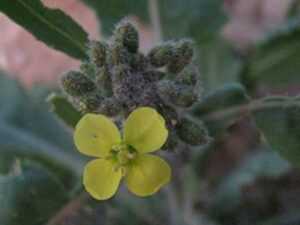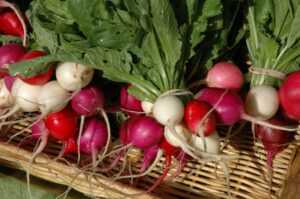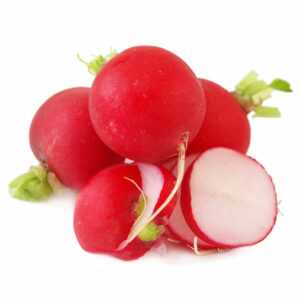I am pleased to report that the date season at Kibbutz Samar is in its prime, with a delicious, fresh delivery of “Brahi” dates on their way to Chubeza soon. These sweet, unique dates, which we offered last year as well, are sold in 5 kg cartons for 100 NIS. (A sharp decrease in this year’s crop yield caused the price to rise.) You can find details on this special date at the Kibbutz Samar Date Site. If you wish to make an order, please contact us as soon as possible.
_____________________________
Radish, Turnip, Eye of Newt……………..
In a popular Hebrew book that my daughters love about five witches (by Ronit Chacham), radishes and turnips are major ingredients in the brew concocted for a spell by five very amusing witches. As it turns out, not only witches crave these vegetables. Among us mortals and muggles, the turnip and radish (along with a small radish and daikon) can be just as vital in a potion to ease the common cold, mucous, hoarseness, coughing, infections and other winter spells. Winter is the season in which the members of the Brassicaceae family (formerly the Cruciferae) grow well. They are cousins, not siblings, since the radishes belong to the Raphanus genus and the turnips to the Brassica genus, but today we will sandwich them all together (or stir them into the same cauldron) and discuss their common characteristics.
So we already know that they all belong to the Brassicaceae family, along with such members as broccoli, cauliflower, cabbage and kohlrabi, mustard greens, tat soi and others. Its former name was the Cruciferae, after the shape of its four-petal flowers, which resembles a crucifix. Here are some examples:
The Brassicaceaes are a venerable winter family, and we eat various parts of their plants: sometimes the flower buds (broccoli, cauliflower), sometimes the stem (kohlrabi) or the leaves (mustard, cabbage, tat soi and others) and also the roots, to whom this newsletter is dedicated today: the radish, little radish, daikon and turnip.
Truth be told, this is a populist division. The good parts of turnip and radishes are not only found underground. For instance, turnip greens are very tasty, and some turnip varieties are grown specifically for their leaves and not roots. The big radish leaves are bitter and coarse, but the greens of small radishes can certainly be used in culinary pursuits. The French add small radish leaves to potato soup and to add a hint of pungency to salads made of steamed spinach. Other varieties of radish and turnips were developed in order to make oil from their seeds. These oils were used in the past, and Maimonides mentions them in discussing those oils permitted for Sabbath candle lighting: “At the outset, one is permitted to use other oils – e.g., radish oil, sesame oil, turnip oil, or the like. It is forbidden to use only those which were explicitly mentioned by our Sages”.(Mishnah Torah, Shabbat, chapter 5 halakha 11)
And now, some words on each of these vegetables:
The turnip is an ancient cultivated growth that was possibly grown in gardens of old in China, Greece, Rome, Egypt and also here. In kitchens throughout, it was a basic, common vegetable. Assaf the Physician (Assaf Harofe Ben Brakhiyahu who lived in 6th century Tiberias) praised the leaves and seeds of the turnip: “The leaves will be useful for all mental distresses and for malaria, while its seeds will be useful in treatment of pain and all sorts of ailments that lead to death.” However, even the juice produced from the root itself is known in folk medicine as beneficial in treating the cough, hoarseness, mucous, and dryness of the nose and mouth. In natural medicine the juice of the turnip is used to treat malaise as well as kidney stones. In order to produce juice, one must press the root. Half a kilo of roots make one glass of juice. Half a kilo of squeezed leaves will make half a glass of juice.
The radish, too, is an ancient common vegetable. It is considered to be a vegetable that arouses the appetite and aids in digestion. Its refreshing taste made a fresh radish salad the perfect choice to cleanse the palate between various meal portions. Its medicinal qualities match those of its cousin, the turnip, in treatment of the kidneys and the respiratory system. In addition, it is a friend to the pregnant lady, as the radish is known to increase fetal movement (and is not as fattening as chocolate) and as a remedy for gas. Dipping swollen feet in a bath of boiled radishes will ease discomfort.
There are many types of radishes, differing in size, shape and color, as well as pungency. Here are some illustrations of several radish beauties:
Instructions for Storing:
-
– Radishes and turnips are roots, i.e., their function is to absorb food and water from the earth in order to supply them to the plant as needed. When picked, we disconnect the plant from its current supply, and the roots hurry to transform the material they had accumulated to the plant’s leaves in order for them to continue to grow. The root itself will eventually become depleted. Therefore, when you receive a radish, turnip, daikon or little radish (and the same goes for beets and carrots) with leaves attached, you must cut the leaves in order to preserve the root’s contents, to keep it fresh and firm for as long as possible.
-
– It’s best to store root vegetables in a closed container to isolate them from the processes in the fridge and the materials secreted from the rest of the vegetables and food.
Radishes and turnips are great served fresh in a salad or sandwich, but don’t forget to use them in cooking as well. Yes, they can be baked and stir fried, and they will please your hearts by adding some coolness to this boiling month of November.
Have a great week. Don’t give up on hopes, prayers, incantations and/or dances for rain—–whatever it takes!
Alon, Melissa, Bat Ami and the Chubeza team
___________________________________________
What’s in this week’s box (besides eye of newt)
Monday: Daikon or turnip or radish, parsley, arugula, red leaf lettuce, green mustard, tomatoes, cucumbers, red beets, sweet potatoes, broccoli, cauliflower-small boxes.
Large box, in addition: lubia or yard-long beans, scallions, nana, cabbage
Wednesday: red leaf lettuce, parsley, cucumbers, mustard greens, red bell peppers, scallions, radish or daikon or turnip, red beet, sweet potatoes, arugula, small boxes-broccoli or cauliflower.
Large box, in addition: Lubia or okra or yard long beans, eggplants or peas, broccoli, cauliflower.
________________________________
Recipes for Radishes and Turnips, plus two Sweet Potato Recipes We Omitted Last Week:
Judy from Beit Shemesh sent this recipe from Laurel’s Kitchen for
Beloved Sweet Potato Salad
-
-Peel sweet potatoes, slice, and sprinkle with salt and olive oil. Bake until soft, but not too soft. Cool.
-
-Cut sweet potato into cubes, add 1 chopped sweet red pepper, and around 3 chopped green onion leaves. Season with grated ginger, grated lemon zest, lemon juice, olive oil and salt to taste.
-
-Add yoghurt if desired.
Rivka, a veteran, faithful client, added a recipe for a wonderful
Pumpkin and Sweet Potato Dessert
-
-Mix in a bowl: 1 cup cubed pumpkin, 1 cup cubed sweet potatoes, 1 T. grated ginger, thin slices of citrus zest, a bit of cinnamon, and ≈2 T. pomegranate concentrate (or to taste).
-
-Heat for several minutes in microwave in a glass or ceramic vessel.
Melissa sent me (and prepared a sample) of this recipe by Roxanne of Kibbutz Gezer, a former organic farmer. It’s easy, tasty and healthy—and perfect to combat the ills of a winter heat wave.
Roxanne’s Daikon Salad
-
-1 c. daikon, coarsely grated
-
-1 t. rice vinegar (or apple or white wine vinegar)
-
-1 t. soy sauce
-
-1 t. toasted sesame oil (dark)
-
-Optional: fresh grated ginger or powdered and/or a bit of sugar
Store in sealed container. Tastes best after refrigerated several hours or overnight.
Melissa also sent me a recipe that proves that radishes can be served at a sumptuous meal:
Neil Ferguson’s Black Radish Gratin (I tried with daikon and it came out great):
- 1/2 kilo black radishes
- 1 cup heavy cream
- 1 cup milk
- 30 grams butter
- 1 clove garlic, crushed
- 1 sprig fresh thyme
- 1 bay leaf
- Pinch nutmeg
- Salt and pepper
Preparation:
-
– Preheat oven to 180 degrees.
-
– Peel radishes and slice them very thinly (1/6 cm if possible) on a mandolin.
-
– In a saucepan, combine the remaining ingredients. Bring to a simmer, then turn off heat and allow to infuse for about 10 minutes.
-
– Strain cream into another saucepan, discarding solids.
-
– Add sliced radishes and simmer over medium heat for about 5 minutes. Remove from heat.
-
– Remove radish slices with a perforated spoon, and layer them in a small casserole. Cover with cream mixture and bake for about 30 minutes, or until golden and bubbly.
And last – links to recipes and tips for radishes (including how to make Tulip Garnishes) and also to three simple recipes with turnips, both from the Green Earth Institute website, a non-profit organic educational farm (and CSA) in Illinois, USA.








